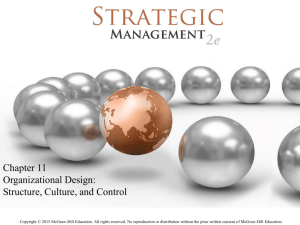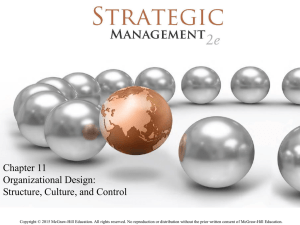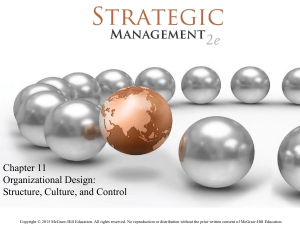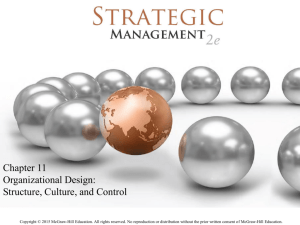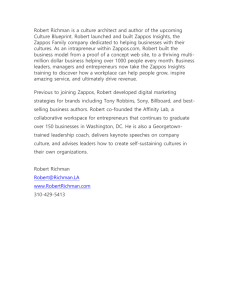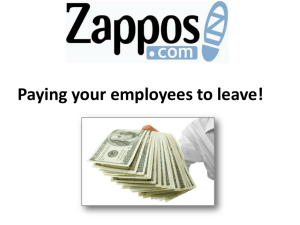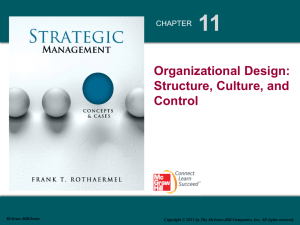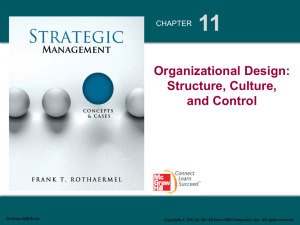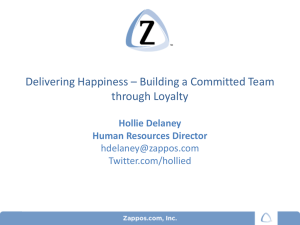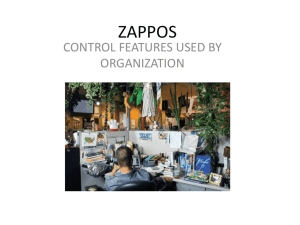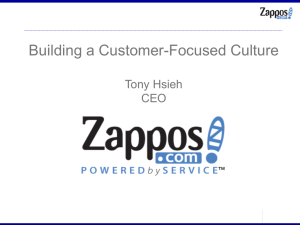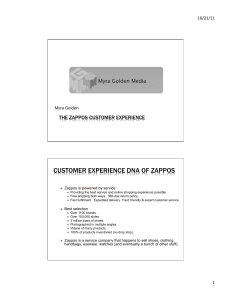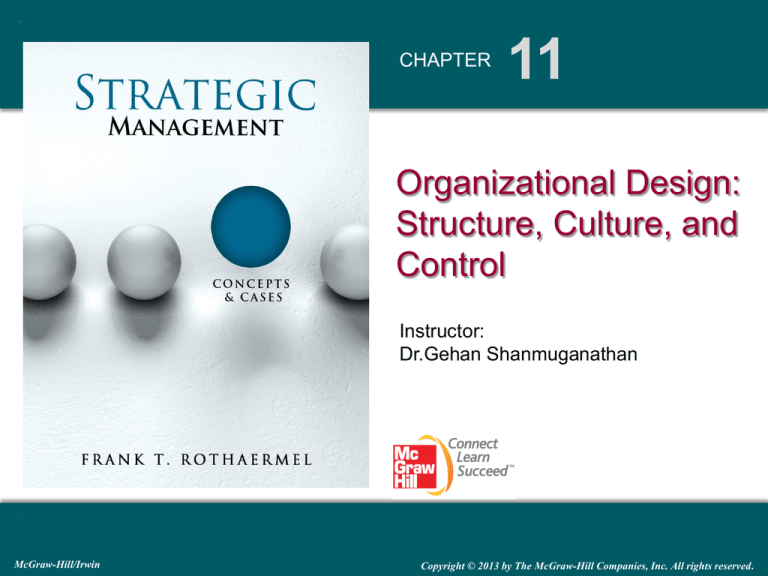
CHAPTER
11
Organizational Design:
Structure, Culture, and
Control
Instructor:
Dr.Gehan Shanmuganathan
McGraw-Hill/Irwin
Copyright © 2013 by The McGraw-Hill Companies, Inc. All rights reserved.
ChapterCase 11
Zappos: An Organization Designed to
Deliver Happiness
• Zappos: Success through customer service
Customer service all in-house
No scripts or timed calls
• Flat Organizational Structure = Flexibility
Job rotation = trained talent
4 weeks of orientation training
Including 2 weeks on customer service phones!
11-2
LO 11-1 Define organizational design and list its three components.
LO 11-2 Explain how organizational inertia can lead established firms
to
failure.
LO 11-3 Define organizational structure and describe its four
elements.
LO 11-4 Compare and contrast mechanistic versus organic
organizations.
LO 11-5 Describe different organizational structures and match them
with
appropriate strategies.
LO 11-6 Describe the elements of organizational culture and explain
where
organizational cultures can come from the how they can be
changed.
LO 11-7 Compare and contrast different strategic control and reward
systems.
11-3
How to Organize for Competitive Advantage
• Organizational design
Goal is to translate strategies into realized ones
Structure
Processes
Procedures
• Structure follows strategies
Structure must be flexible
Yahoo failed to make changes to their
organizational structure!
11-4
EXHIBIT 11.2
Organizational Inertia
11-5
The Key Elements of Organizational
Structure
• Organizational structure determines
Work efforts of individuals and teams
Resource distribution
• Key building blocks
Specialization
Formalization
Centralization
Hierarchy
11-6
Assembling the Pieces: Mechanistic vs.
Organic Organizations
• Organic organizations
Low degree of specialization and formalization
Flat structure
Decentralized decision making
Uses virtual team due to information technology
Example: Zappos, W. L. Gore, and many high-tech firms
• Mechanistic organizations
High degree of specialization and formalization
Tall hierarchy
Centralized decision making
Example: McDonald’s
Video on Web 2.0
Changing workplace
11-7
Matching Strategy and Structure
• Simple structure
Small firms with low complexity
Top management makes all important strategic
decisions
Low degree of formalization and specialization
A basic organizational structure
Examples: small advertising, consulting, accounting, and
law firms
11-8
Functional Structure
• Functional structure
Groups of employees with distinct functional areas
The areas of expertise correspond to distinct stages
in the company value chain activities
Example: College of Business Administration, School of
Management…etc.
• Recommended with narrow products/services
Matches well with business-level strategy
Cost leadership Mechanistic organization
Differentiation Organic organization
Integration strategy Ambidextrous organization
11-9
Multidivisional Structure
• Multidivisional structure
Consists of several distinct SBUs
Each SBU is independent and led by a CEO
Each CEO of SBUs report to the corporate office
Examples:
Zappos is an SBU under Amazon
Skype is an SBU under Microsoft
Paypal is an SBU under eBay
Companies using M-form structure
GE, Honda
11-10
EXHIBIT 11.7
Typical M-Form Structure
Functional Structure
Matrix Structure
11-11
Matrix Structure
• A combination of functional and M-form
structure
Creation of dual line of authority and reporting lines
Each SBU receives support both horizontally and
vertically
Very versatile
Enhanced learning from different SBUs
• Shortcomings
Difficult to implement
Complexity increases when expanding, especially
globally
Unclear reporting structure causes confusion and
delays
11-12
Organizational Culture
• Culture must be valuable, rare, inimitable, and
non-substitutable (RBV)
Causal ambiguity and social complexity
• Organizational culture is an important resource!
Southwest Airlines
Friendly and energized employees work collaboratively
Zappos
Deliver WOW through service
11-13
Strategic Control and Reward Systems
• Internal governance mechanisms
Culture
Sanctions
• Input controls
Rules and standard operating procedures
Budgets
Behavior guidelines
• Output controls
Result-oriented
ROWEs
Dan Pink’s
RSA Video
11-14
ChapterCase 11/ Consider This
• WOW factors became WOW mistakes
• Erroneous price cap not discovered for 6 hours
• Zappos honored the sales placed during the
time with mistaken price$49.95 everything!
• Customers are happy due to the fact that
Zappos handled the situation smoothly
• This is the real WOW!!!
11-15

